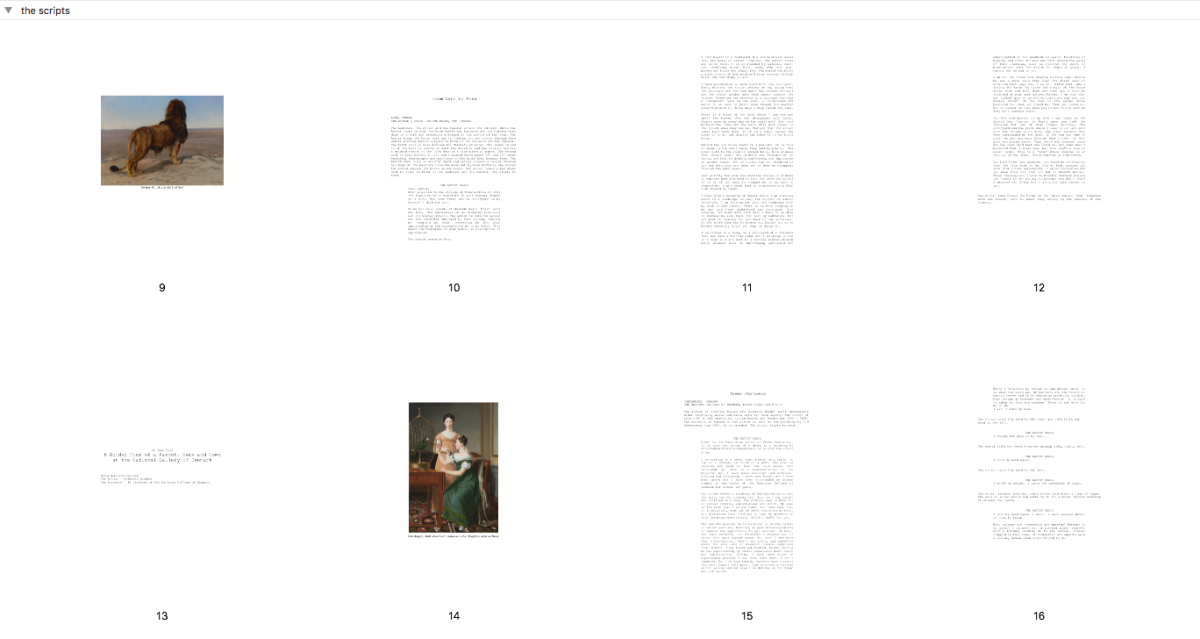RESISTANCE WITHIN THE MUSEUM FAUNA
Challenging Anthropocentrism through Counter Art Histories and Non-Human Narratives
A thesis in artistic research and critical animal studies by Dr. EvaMarie Lindahl – Edge Hill University, 2022
ARTWORKS
Here are the artworks that belong to the thesis Resistance within the Museum Fauna – Challenging Anthropocentrism through Counter Art Histories and Non-Human Narratives. The artworks are structured into four different sections: text-based artworks, performance onsite, performance online and video works. Not all artworks are fully visible here on the site because of the nature of the work or the specific setting, such as conference presentations.
PERFORMANCE – onsite
→ At the Bishop’s House in Lund
→ At Nationalmuseum in Stockholm
→ At the National Gallery of Denmark
VIDEO WORKS
→ The Artist Named me Nero
→ Resistance Within the Museum Fauna
THE SCRIPTS - text based artworks
– link to the scripts as pdf is found here –
(opens in new window)
PERFORMANCE - onsite
– At the Bishop’s House in Lund –
A Guided Tour of Lions and Cattle at the Bishop’s House in Lund
A Guided Tour of Lions and Cattle at the Bishop’s House in Lund is a text based artwork written to be performed as a guided tour of artworks on display at the Bishop’s House in Lund belonging to the Lund University Art Collection. The text was performed on October 27 2017.
A Guided Tour of Lions and Cattle at the Bishop’s House in Lund was performed in connection to the 5th European Conference for Critical Animal Studies and with generous support from the Bishop’s House and Lund University Art Collection.
These are the three paintings that the work is based on:
Flodlandskap med boskap (Riverbed with Cattle) n.d by Aelbert Cuyp
Ladugårdsinteriör (Barn Interior) n.d by Anon
Lion (The Look Out) n.d by Rosa Bonheur
Here follows images documenting the tour at Nationalmuseum on October 27 2017. The entire text-based work is found in THE SCRIPT.
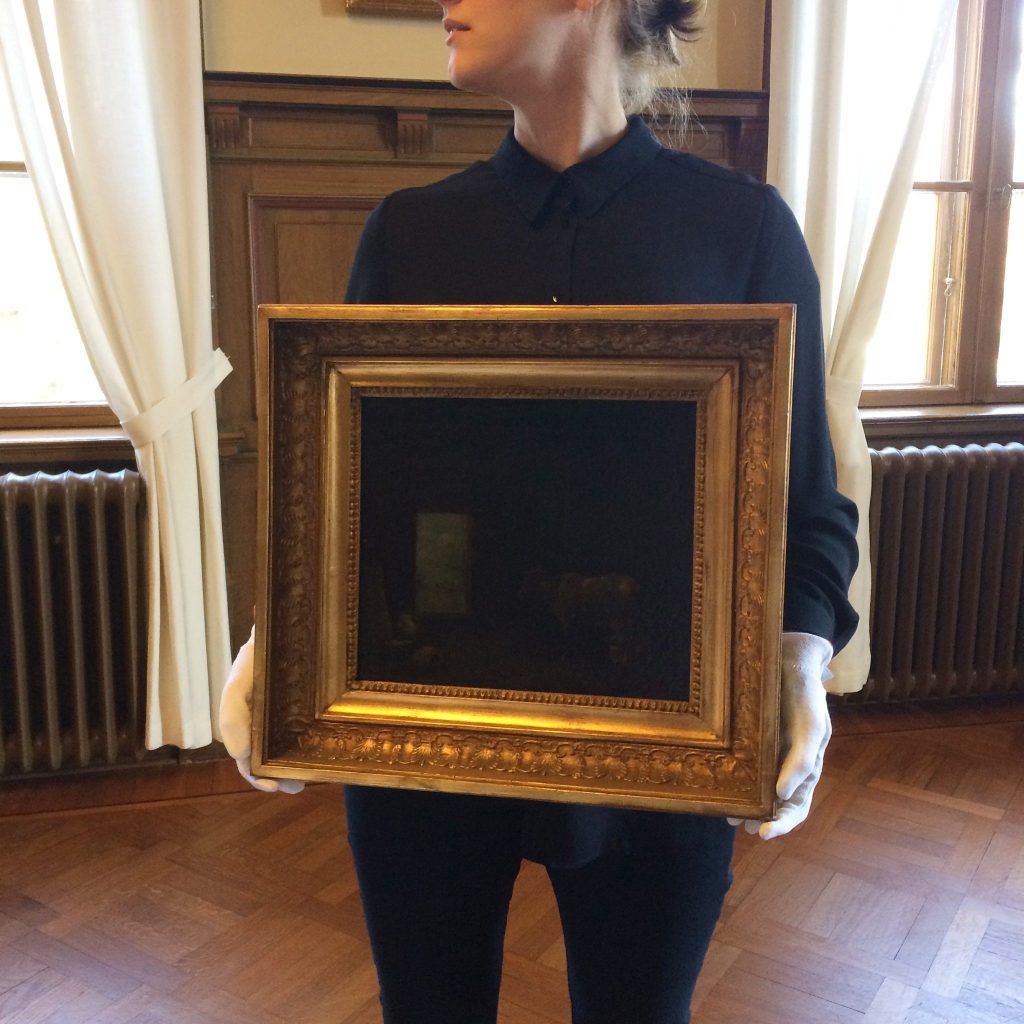

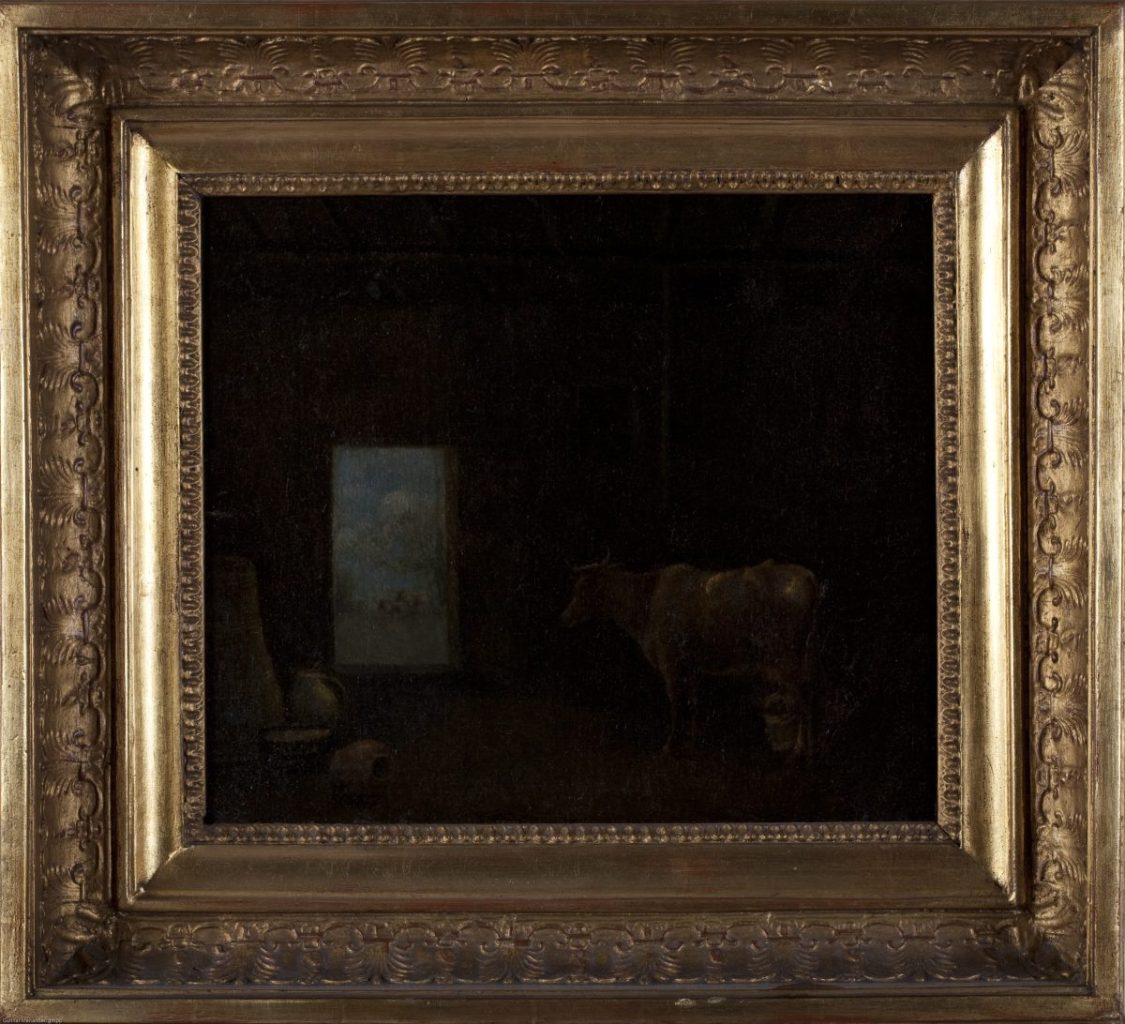
An excerpt from
WHITE PIGMENTS OUT OF BONES
The Bishop’s House, third floor, The Grand Hall
The Artist sits down by the end of the table, in front of the objects, she asks the Audience to join her. The Curator is standing next to the Artist, holding the painting, so that the Audience can see the painting while listening to the Artist who starts to read:
More shades of white are available commercially than any other colour.
White pigment out of led
White pigment out of chalk
White pigment out of titanium dioxide
White pigment out of zinc
White pigment out of bones
Titanium white was produced for the first time in 1820. Production in an industrial scale didn’t start until one hundred years later. Titanium white is highly opaque. You can’t see what is hidden underneath. It covers. At the same time as a thick opaque white surface can be painted by artists, the industrialization of cows picks up speed. Thousands and thousands of litres of white, running through pipes. Slowly as the whiteness thickens the reality at the factory becomes even more impenetrable, non-transparent, cruel and effective.
The Artist puts the paper card back from where she picked it up. She moves the two milk jugs so that they are placed in front of her on the table. She picks up the metal tube with titanium dioxide, removes the cork to squeeze the paint into one of the milk jugs before she puts the cork back on and puts the tube down. She takes the milk jugs in her hands and with her right hand she pours the water from one milk jug into the other that contains the paint. She moves the milk jug that now contains both paint and water to her right hand and pours the liquid back into the milk jug now placed in her left hand. The water is no longer fully transparent but has a very slight white colour. The Artist repeats the procedure, shifting hands and pouring the fluid from one milk jug to the other. The liquid becomes whiter. She repeats this procedure, pouring the liquid back and forth, until it turns into an opaque white. The Artist puts the milk jugs down. The artist reads:
I have white milk. White milk that will keep my sisters in shackles for millennia. I have white bones. White bones that can create white pigment that can shape form and sunlight and therefore landscape.
PERFORMANCE - onsite
– At Nationalmuseum in Stockholm –
A Guided Tour of a Squirrel, Marmot, Cat and a Capercaillie at Nationalmuseum in Stockholm
A Guided Tour of a Squirrel, Marmot, Cat and a Capercaillie at Nationalmuseum in Stockholm is a text based artwork written to be performed as a guided tour. It was written for The Timeline exhibition of Nationalmuseum and evolves around the experiences of the non-human animals inhabiting five of the paintings that can be seen in the exhibition. The text was performed at Nationalmuseum in Stockholm, Sweden, on January 30th 2019.
A Guided Tour of a Squirrel, Marmot, Cat and a Capercaillie at Nationalmuseum in Stockholm was performed in collaboration with Nationalmuseum and Konstfack Research Week and partially funded by Konstnärsnämnden through a project grant.
These are the five paintings that the work is based on:
Wild Cat 1850 by Rosa Bonheur (1822-1899)
Peasant Girl Milking a Cow 1659 by Karel Dujardin (1626-1678)
Murmeldjur n.d by David Klöcker Ehrenstrahl (1628-1698)
White Squirrel in a Landscape 1697 by David Klöcker Ehrenstrahl (1628-1698)
Bringing Home the Body of King Karl XII of Sweden 1884 by Gustaf Cederström
Here follows images documenting the tour at Nationalmuseum on January 30 2019 and an excerpt from the performed text. The entire text-based work is found in THE SCRIPTS.
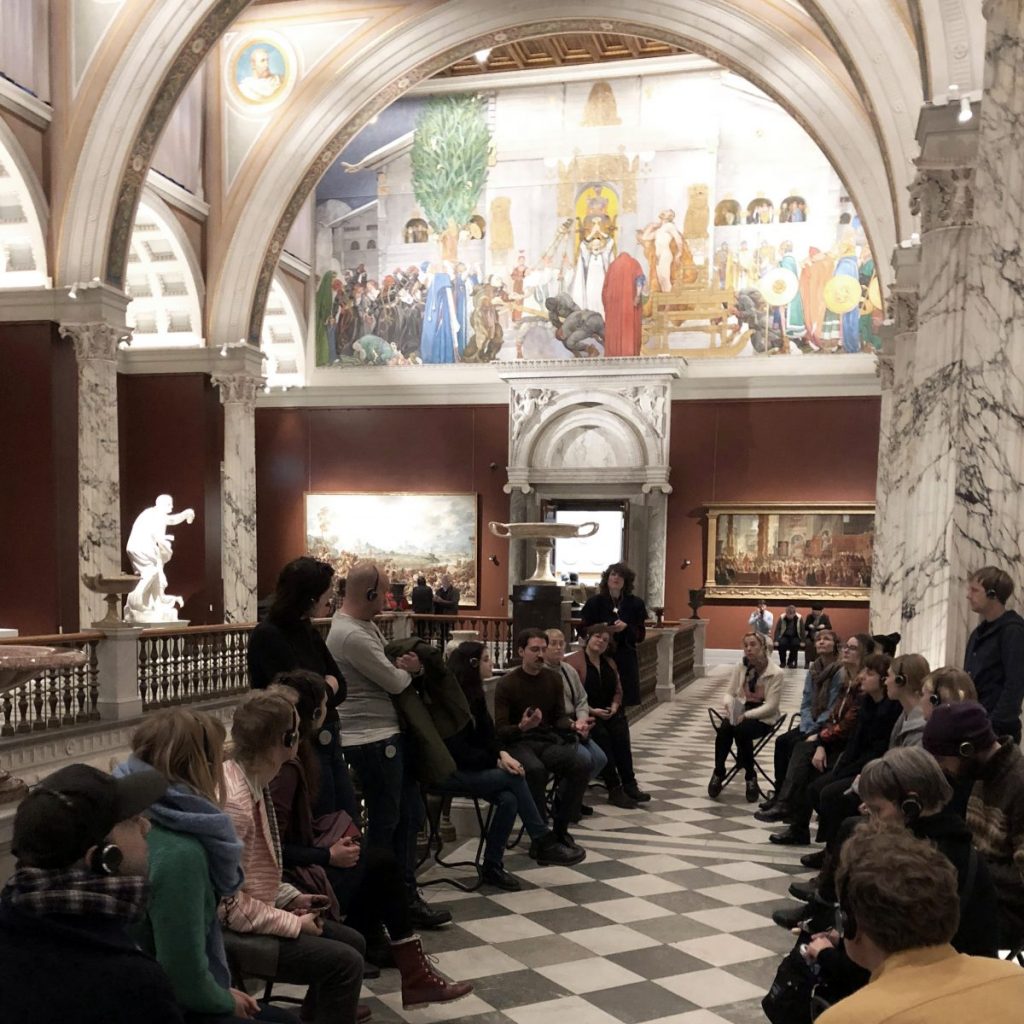
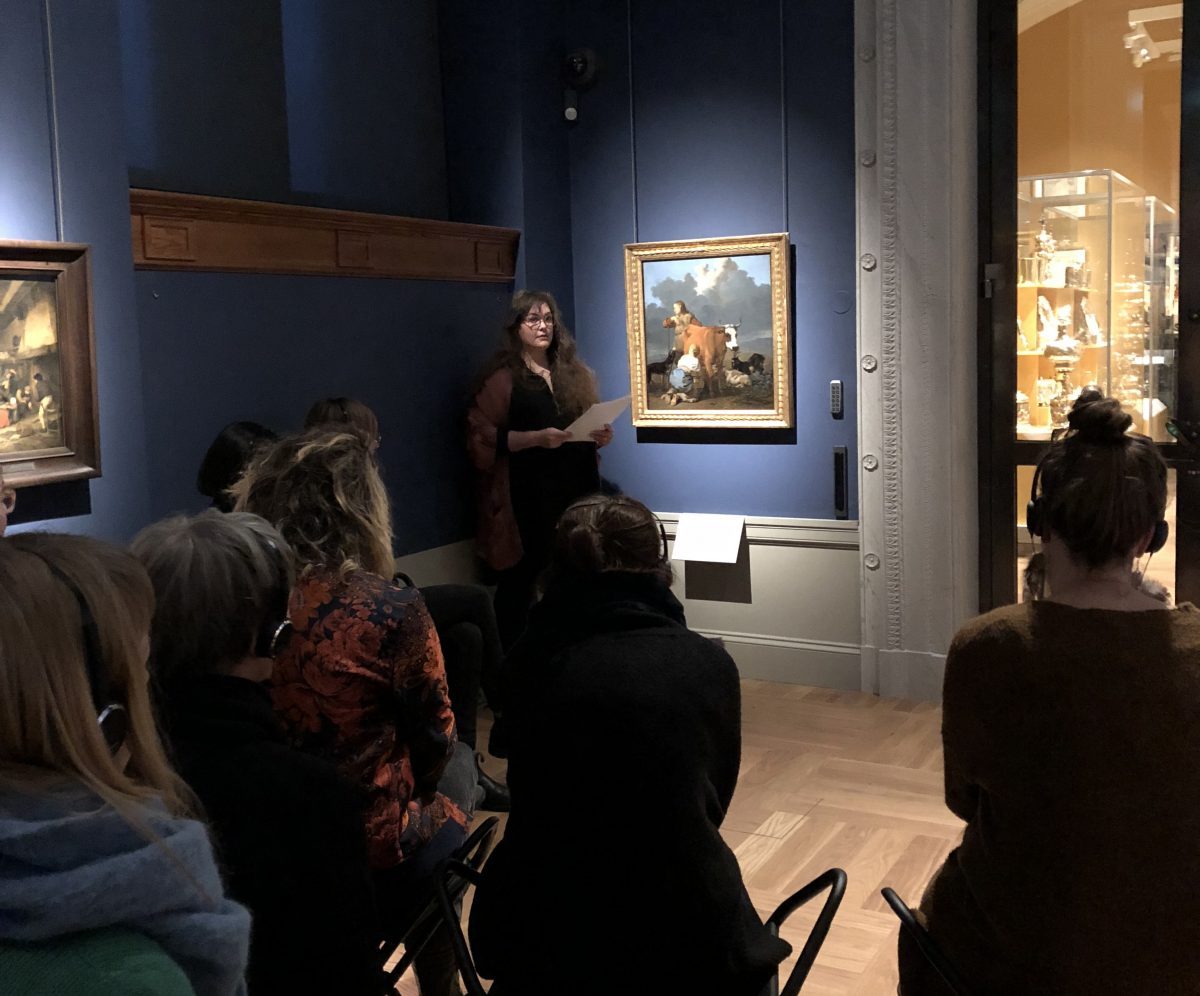
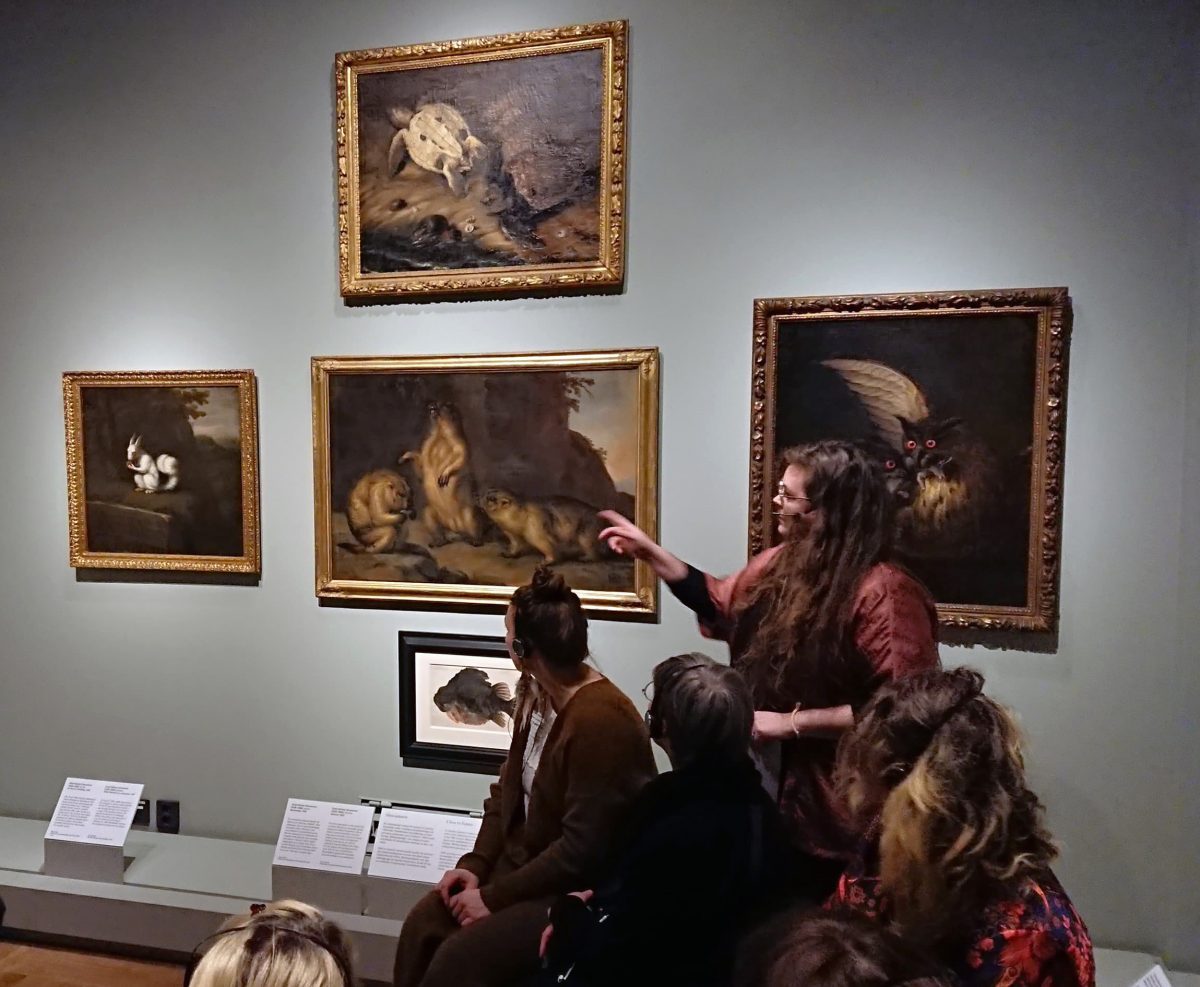

An excerpt from
BRINGING HOME THE BODY OF KING KARL XII OF SWEDEN
Nationalmuseum, fourth floor
The artist is standing infront of the painting. The audience is gathered in a semicircle facing the painting. The artist reads:
Follow the wind and you will find me. The icy cold wind whips the royal standard forcing the soldier carrying the flag to struggle, holding hard with both hands. The wind lifts his coat, hurrying on, almost catching the hat of another soldier before grabbing his coat, turning it into life. Then suddenly, the wind is pushed to the ground carrying snow over the ledge pushing snow behind the golden frame and out of reach of this painting. And there you have me. In front of the snow falling over the ledge, on the back of the huntsman. Hanging upside down with my head dangling towards the humans back side. Blood dripping from my beak, leaving a small trace of red in the snow-filled footprint of the human who killed me. Here I am. And I refuse to be read symbolically.
I am what Carl Linnaeus defined as TETRAO UROGALIUS. You call me capercaillie, wood grouse or as they say in the province of Jämtland: tjäder, gråfågel or fjärrhane. Whether my name is given me in relation to the colors of my feathers or because of the relation to other birds in a never-ending organization of all that is living, the names control me.
I find myself within the golden frames of this painting by Gustaf Cederström from 1884, but you can also find me in an earlier version from 1878. Both paintings are named Bringing Home the Body of King Charles the twelfth of Sweden.
Just as there are two physical representations of me there are two ways for you to see and read my presence: Either as a symbol or as a once living being. I refuse to think of myself as a symbol, and therefore urge you to read me as living. Because once I was alive. Or once someone was alive for someone else to kill and later study. Humans wants other animals to be still so that they can study. So that you can create a perfect watercolor drawing of the back feathers of someone like me. And it takes several. I am not only one. I am a series of me. I am an US.
The artist used his brother, colleagues, friends, and his child to stand as models for some of the painted humans, but to be able to paint us he had to study one of our kind, hanging upside down. To paint us we had to be killed.
PERFORMANCE - onsite
– At the National Gallery of Denmark –
A Guided Tour of a Parrot, Gees and Cows at the National Gallery of Denmark
A Guided Tour of a Parrot, Gees and Cows at the National Gallery of Denmark is a text based artwork written to be performed as a guided tour. It was written for the exhibition Danish and Nordic Art 1750-1900 at the National Gallery of Denmark and evolves around the experiences of the non-human animals inhabiting six of the paintings that can be seen in the exhibition.
Green Feathers was made in connection with the European Society for Literature, Science and the Arts Conference GREEN 2018 and the event Green Friday at the National Gallery of Denmark, and partially funded by Konstnärsnämnden through a project grant.
These are the six paintings that the work is based on:
Mendel Levin Nathanson’s Elder Daughters, Bella and Hanna 1820 by C.W Eckersberg (1783-1853)
Plucking the Gees (Julegæssene plukkes) 1904 by Anna Ancher (1859-1935)
Zealand Landscape. Open Country in North Zealand 1842 by Johan Thomas Lundbye (1818-1848)
Two Cows in an Open Field 1845 by Johan Thomas Lundbye (1818-1848)
A Croft at Lodskov near Vognserup Manor. Study 1846 by Johan Thomas Lundbye (1818-1848)
A Croft at Lodskov near Vognserup Manor, Zealand 1847 by Johan Thomas Lundbye (1818-1848)
Here follows images documenting the tour at the National Gallery of Denmark on June 15 2018 as well as an excerpt from the performed text. The entire text-based work is found in THE SCRIPTS
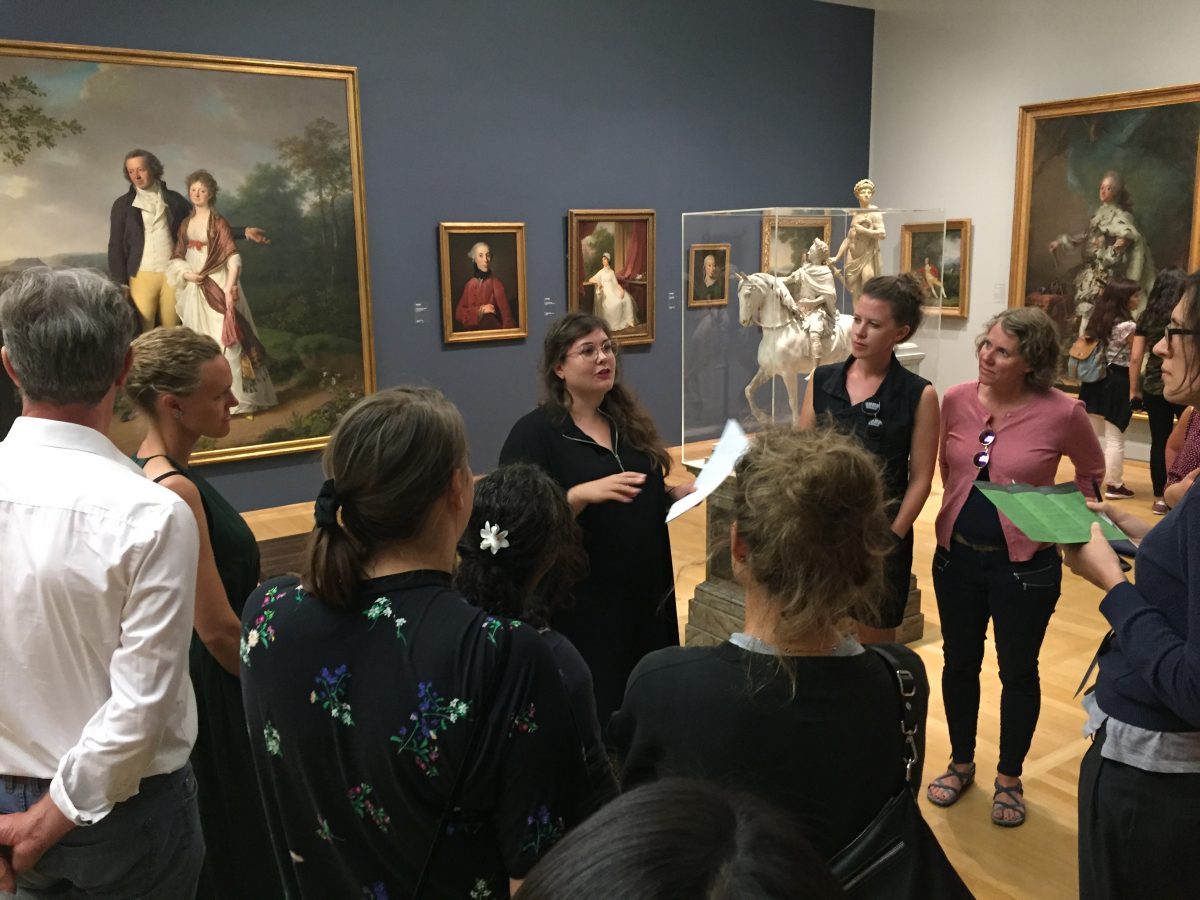
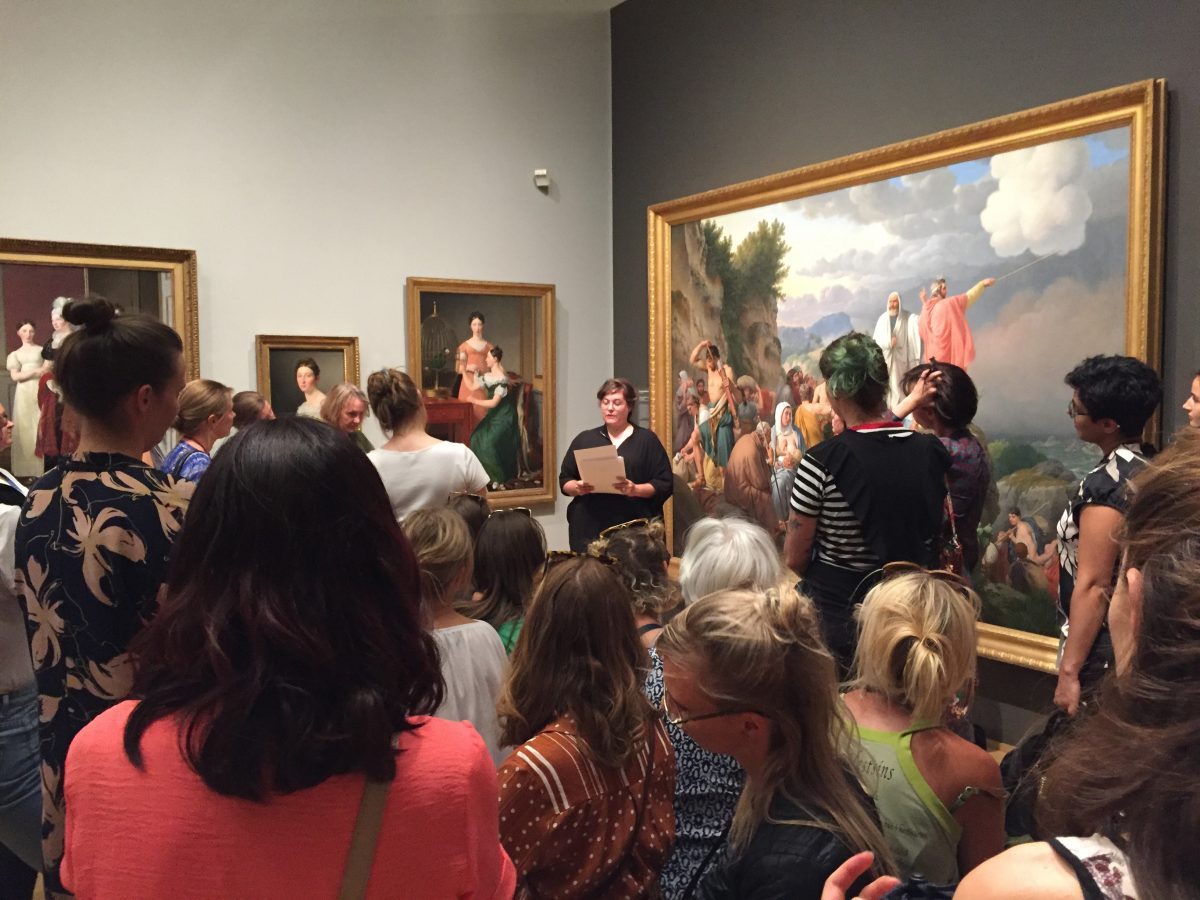
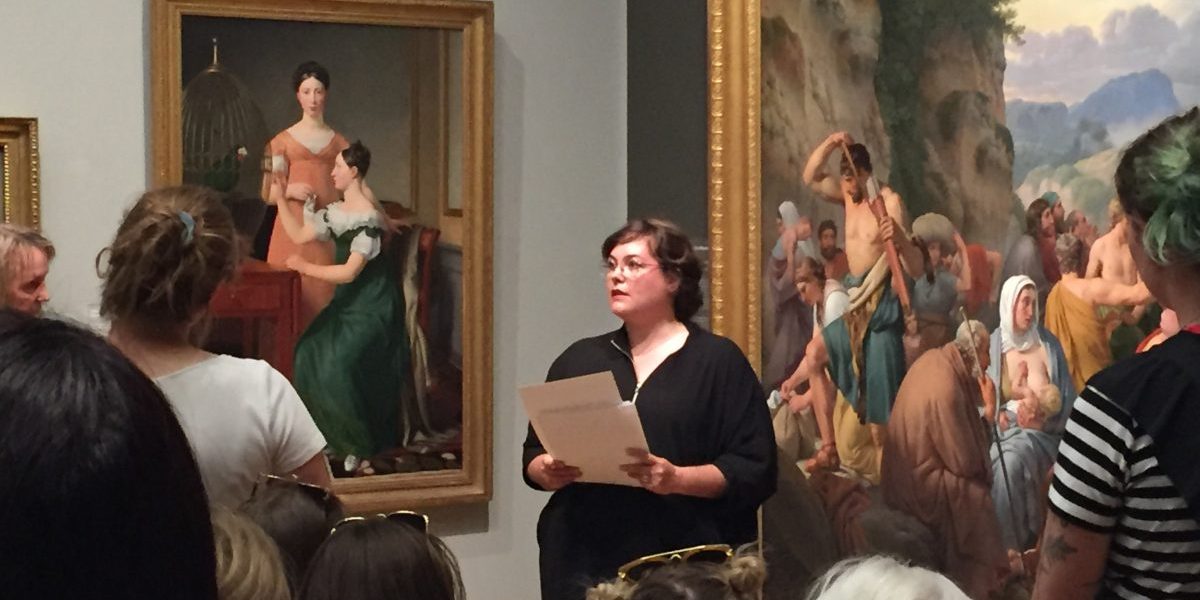
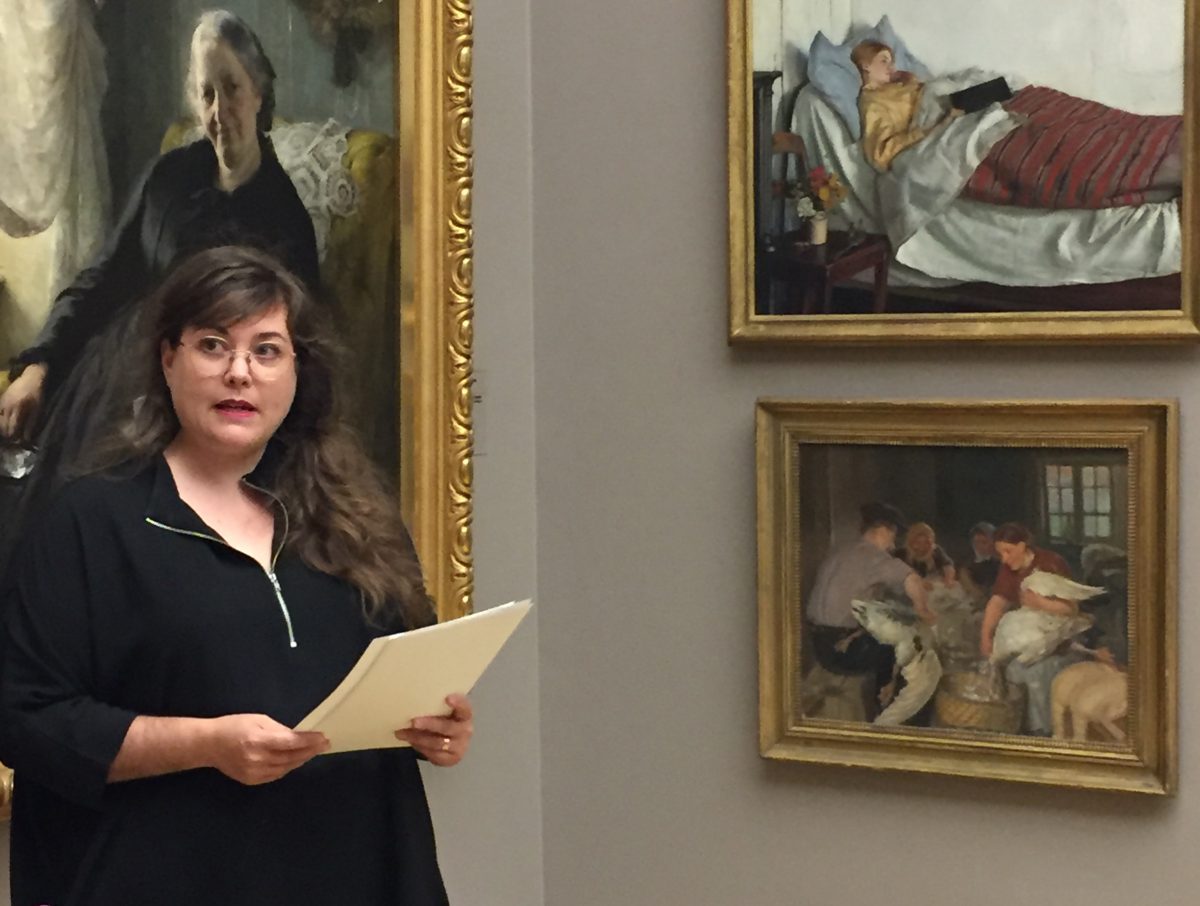
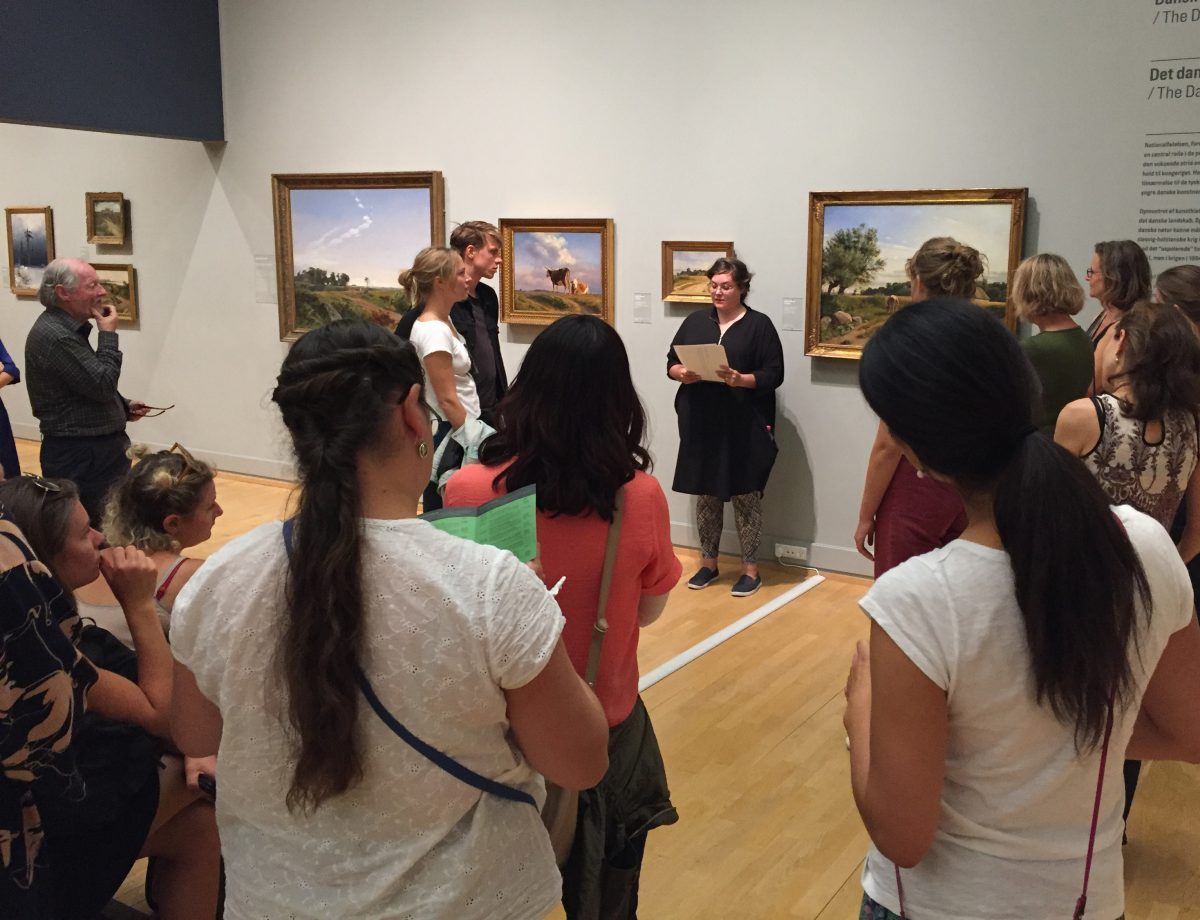
PERFORMANCE - online
– At the European Association for Critical Animal Studies Conference 2021 –
Resistance within the Museum Fauna – a reading of a ten meter long collage
Resistance within the Museum Fauna – a reading of a ten meter long collage is an online presentation/performance at the European Association for Critical Animal Studies Conference in 2021 that presents counter art historic narratives for the 59 paintings involved in different layers of this thesis.
PERFORMANCE - online
– At the Multispecies Heritage Conference –
Tearing the White Glove – a wild cat resists
Mossy Boulders – eight cows resist
Tearing the White Glove – a wild cat resists and Mossy Boulders – eight cows resist is an online performance/virtual guided tour as part of a presentation at the Multispecies Heritage Conference November 26, 2020. The guided tour visits Nationalmuseum in Stockholm and The National Gallery of Denmark.
PERFORMANCE - online
– At the Conference Multispecies Storytelling in Intermedial Practices –
The Birds – Red, White, Green
The Birds – Red, White, Green is a performance/virtual guided tour as part of a presentation at the conference Multispecies Storytelling in Intermedial Practices. The guided tour takes place at Nationalmuseum in Stockholm and The National Gallery of Denmark in Copenhagen. It was originally performed live at the conference and later it has been performed and recorded as an online event at Konstskolan Munka.
VIDEO WORKS
– The Artist Named Me Nero –
05:39
The Artist Named Me Nero is a video work about the lion Nero, caged by the French animal painter Rosa Bonheur at her castle in Fontainebleau and portrayed in several of her paintings. The video tells of an alternative history of the paintings of Nero, from the perspective and life of Nero himself.
What is it like, as a non-human animal, to be part of the history of art and its production system, that often seem to build upon oppression and violence towards the ones not human? What happens if we refuse to read the once living, and portrayed, symbolically and instead focus on their relationships and agency?
The video brings forward the imagined experiences and dreams of Nero, by telling a less anthropocentric version of history while using anthropomorphism and empathy as methods to imagine these new experiences.
Supported by Konsthallen at Falsterbo Strandbad and Julius Dahlström, performed at Weltkunstzimmer for for the opening of the exhibition Goodbye Cruel World It’s Over.
VIDEO WORKS
– Resistance within the Museum Fauna –
08:39
Resistance within the Museum Fauna is a digital collage of the artworks this thesis has responded to in text, video and performance. The digital collage functions as a video work with or without voiceover (here without voiceover, a version with voiceover can be listened to and seen performed in the online performance Resistance within the Museum Fauna – a reading of a ten meter long collage above), as a printed physical collage and as an introduction chapter to the book Resistance within the Museum Fauna. The collage is comprised of 59 paintings.
Ploughing in the Nivernais (1849) Rosa Bonheur
Sea Eagles (1897) Bruno Liljefors
Mendel Levin Nathanson’s Elder Daughters, Bella and Hanna (1820) Christoffer Wilhelm Eckersberg
The Shepherd David (ca. 1895) Elizabeth Jane Gardner
My Wife’s Lovers (1893) Carl Kahler
The Arab Tent (1886) Edwin Henry Landseer
Ritratto della famiglia Maselli (1565-1614) Fontana Lavinia
Cat and Fish (n.d.) William Huggins
Napoleon Crossing the Alps (1800) Jacques-Louis David
The Kongouro from New Holland (1772) George Stubbs
The Madonna of the Rabbit (1530) Titian
The Highland Shepherd (1859) Rosa Bonheur
The Threatened Swan (c. 1650) Jan Asselijn
Monarch of the Glen (c.1849 – c.1851) Edwin Henry Landseer
Isaac van Amburgh and his Animals (1839) Edwin Henry Landseer
Ziva, a badger dog belonging to the hereditary Prince of Saxe-Coburg-Gotha (n.d.) Sir Edwin Henry Landseer Arrival of the Hungarians (1894) Árpád Feszty
The Hippopotamus and Crocodile Hunt (1615) Peter Paul Rubens
The Death of Sir William Lambton at the Battle of Marston Moor (1842) Richard Ansdell
Barbaro after the Hunt (c.1858) Rosa Bonheur
Playmates – (Manchester Terrier) (n.d.) Briton Rivière
The Nubian Giraffe (1827) Jacques-Laurent Agasse
Two Cows in an Open Field (1845) Johan Thomas Lundbye
Still Life: Game, Vegetables, Fruit, Cockatoo (1650) Adriaen van Utrecht
Alexandra of Denmark (1920, orig 1894) after Luke Fildes
Hawking in the Olden Time (1831) Sir Edwin Henry Landseer
Head of a Stag (1626-1636) Diego Velázquez
Landscape with a Fountain, Figures and Animal (n.d.) Francesco Zuccarelli
Head of a Roebuck and Two Ptarmigan (c. 1830) Edwin Henry Landseer
Compulsory Education (1887) Briton Rivière
The Dachshound Pehr with Dead Game and a Rifle (1740) Jean-Baptiste Oudry
The Goldfinch (1654) Carel Fabritius
Still Life with a Rifle, Hare and Bird (”Fire”) (1720) Jean-Baptiste Oudry
The Horse Fair (1852-1855) Rosa Bonheur
A Reclining Tiger (n.d.) Géza Vastagh
Two Crabs (1889) Vincent van Gogh
Lady with an Ermine (1489–1490) Leonardo da Vinci
The Start of the Race of the Riderless Horses (1820) Horace Vernet
L’hallali du loup (1725) Jean-Baptiste Oudry
Un canard col-vert attaché à la muraille et une bigarade (c. 1730) Jean-Baptiste-Siméon Chardin
Dead Fox (1848) Frants Diderik Böe
Still Life with a Dead Bird and Hunting Gear (1744) Guillaume Taraval
The Ladies’ Army Remount Dep’t, Russley Park, Wiltshire, 1918 (1919) Lucy Kemp-Welch
Still life with birds and pocket knife (c. 1700-1740) Johann Adalbert Angermeyer
Hector, Nero, and Dash with the parrot, Lory (1838) Edwin Henry Landseer
Beagle and Fox (1885) Bruno Liljefors
Dead Birds (1735) Anton Friedrich Harms
Highland Raid (1860) Rosa Bonheur
Portrait of a Lady with a Rabbit (1508) Ridolfo Ghirlandaio
Head of a Horse (n.d.) Eugene Verboeckhoven
Buzzard with Ptarmigan (1876) Richard Ansdell
The Lamb of God (1635-1640) Francisco de Zurbarán
The Japanese Fan (c. 1865) Gustave Léonard de Jonghe
A Fox Family (1886) Bruno Liljefors
Horses bathing in the sea (1900) Lucy Kemp-Welch
Plucking the Gees (1904) Anna Ancher
A Young Girl Plucking a Swan (c. 1899) Anna_Ancher
The Beach at Villerville (1864) Eugène Boudin
